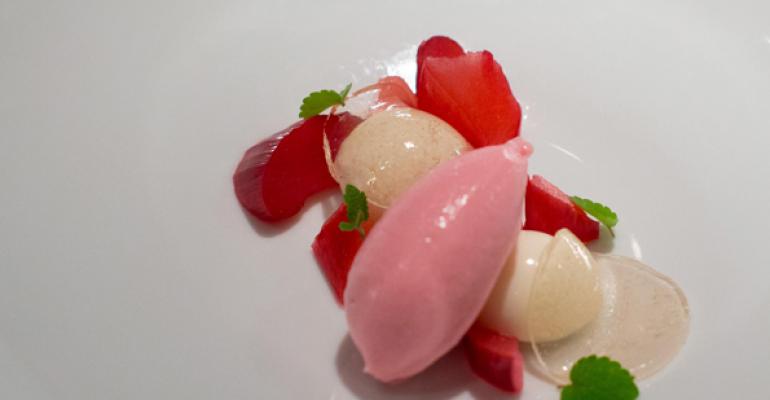Chef Kym Delost wasn’t really interested in making jams or preserves — until about eight years ago when she over-reduced a sorbet she was making. “That’s when I started to appreciate [them],” said Delost.
Now, “I really like jam [and preserves]… It gives the ability to present different flavors in different ways,” she said.
Delost’s dessert menu at Storefront Company in Chicago features traditional preserves, such as apricot preserves with a chocolate, almond and rosemary crepe, as well as more unusual variations. Those include a crumble with grapefruit pate de fruit; a white chocolate cheesecake with basil cream, blood orange jelly, blood orange gel, meringue and basil blossoms; and poached rhubarb and rhubarb sherbet with angelica jelly.
RELATED
• Restaurants supersize dessert
• Artisanal doughnuts trend on menus
• Dessert Trends at NRN.com
Across the country, chefs are finding pleasure in using seasonal berries and other ingredients to create interesting flavor mash-ups of traditional jams, jellies and preserves.
Michelle Lee, the new pastry chef at Restaurant 1833 in Monterey, Calif., takes advantage of the region’s abundant produce to reduce flats of berries and then combine them with herbs and other ingredients for her work-in-progress dessert menu. For example, Lee recently added to the menu a raspberry lemonade sorbet with strawberry meringue, olive oil cake, candied lemon, vanilla cream and an elderflower blackberry jam.
“I love, love, love rustic desserts,” said Lee. “[Jams] are unique to have. It’s familiar, but it’s something you can play with as well.”

Lee, who keeps a “big idea book” filled with flavor combinations waiting to be realized, plans to add one or two more desserts to the menu in the coming months, perhaps including a pate de fruit made from blueberries.
Other chefs are finding that adding jams and preserves is not only creative, but also economical. They can buy fruits and berries in bulk when they’re in peak season and the cost is low, and then turn them into something else to be served well beyond the season.
“It’s a good way to control costs,” said chef Trevor Higgins. “Besides just having a berry as it is, you can add flavors … cinnamon, star anise, garlic. You still have these products in a different form, a little more unique.”
This winter Higgins made a lot of blackberry preserves that are now starting to appear on the menu at Roost, a local, organic, seasonal Southern-food restaurant in Greenville, S.C. Currently, Shoo Fly Pie topped with blackberry preserves and chipotle, cayenne, bourbon gelato is on the menu. A four-layer chocolate mousse cake with blackberry preserves was a recent special, and Higgins plans to take advantage of the upcoming peach season next.
“Growing up in Tennessee, we always had preserves,” said Higgins. “I used to help my grandma can. [It’s] part of the up-bringing of Southern food.”
For chef Matt McCallister of FT33 in Dallas, playing with preserves is an extension of his nose-to-tail philosophy of cooking. Preserved items in all forms appear in every section of his seasonally driven menu — from pickled kumquats to Moroccan preserved lemons.
“I don’t like to waste anything. If I have a part of a fruit or a vegetable I’m not using, I’ll always try to preserve it,” said McCallister. “I love the flavor of preserved stuff.”
His dessert menu features a classic strawberry shortcake with strawberry preserves, as well as a variety of jams, including rhubarb, carrot, beer and red currant, served as part of a cheese board.





